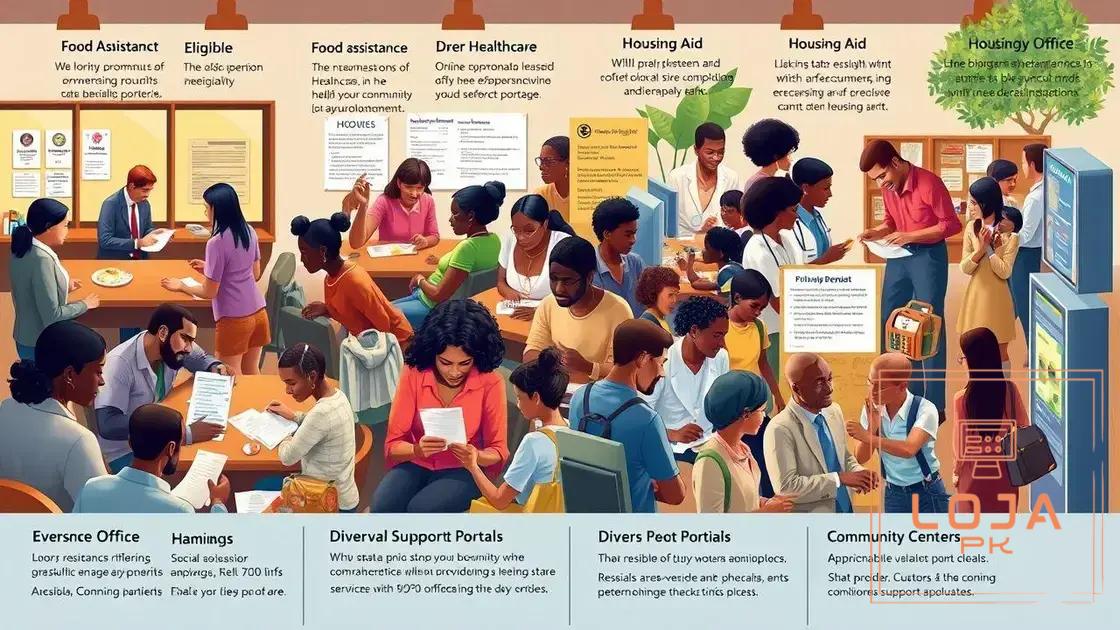Benefit program management varies widely across states

Benefit program management varies widely across states due to differences in eligibility, application processes, and available services, impacting how residents access crucial support.
Benefit program management varies widely across states. This diversity can impact how residents access essential support services. Are you aware of the unique offerings in your state? Let’s explore the variations together.
Understanding the benefit program landscape
Understanding the benefit program landscape is essential for navigating the various support options available to residents. Each state has its own set of programs designed to assist individuals and families. Let’s dive into what makes these programs unique.
Types of Benefit Programs
Benefit programs are designed to offer assistance in various areas. They can include health care, financial aid, and educational support. States often tailor these programs to meet the needs of their residents.
- Healthcare assistance through Medicaid and CHIP
- Food assistance via SNAP programs
- Financial aid for low-income families
- Job training and education grants
Each of these categories represents a different way that states can support their communities. However, eligibility criteria can vary widely. For example, some states may offer more generous income thresholds for Medicaid eligibility than others.
Impact of State Regulations
The regulations set by state governments greatly influence the administration of these programs. Some states have lengthy application processes, while others have streamlined their systems for better accessibility. Understanding these rules can help residents make informed decisions.
It’s also important to recognize how state resources are allocated. Programs that are well-funded can provide a higher level of service. For instance, states that invest in technology may offer online applications and faster processing times.
Examples of State Differences
Consider the differences in benefit programs across the country:
- California’s extensive healthcare network compared to Texas
- New York’s robust public assistance programs versus Florida’s eligibility restrictions
- North Dakota’s limited options versus Massachusetts’ comprehensive support
These examples highlight the need for residents to stay informed about their state’s offerings. Being aware of what is available can make a significant difference in accessing the necessary support.
Future of Benefit Programs
The future of benefit programs is continually evolving. States may introduce new initiatives to better meet the needs of their residents. Keeping an eye on legislative changes can help individuals stay up-to-date.
As advocacy for support programs grows, residents should engage in community discussions to ensure their voices are heard. This engagement can lead to improvements in the programs that directly affect their lives.
Key differences in state benefit programs

There are many key differences in state benefit programs that can affect how residents receive assistance. Each state operates its programs based on local needs and regulations, leading to unique offerings across the nation.
Eligibility Criteria
One major difference is in the eligibility criteria for various programs. Some states have strict income limits, while others may offer more flexible options. This can significantly impact who qualifies for essential services.
- Low-income thresholds vary by state
- Some states have expanded Medicaid options
- Eligibility for food assistance differs widely
- Educational grants may have variable requirements
Additionally, this variability means that understanding local regulations is vital for accessing available resources. For example, a family living in one state might easily qualify for assistance, while a similar family in another state may not.
Types of Available Benefits
Another aspect to consider is the range of benefits offered. Some states provide extensive health care programs, including Medicaid and CHIP, while others focus more on financial aid and food assistance.
States like New York might have comprehensive public assistance programs, while others like Arkansas may have limited options. This can create disparities in how residents meet their basic needs.
Moreover, it’s important to note that some states have innovative programs designed to address specific community challenges. These local initiatives can significantly enhance the support available.
Application Processes
The application processes for benefit programs can also differ greatly between states. Some states utilize online platforms for easy access, while others may rely on in-person applications, which can be time-consuming.
- Online application processes have become more common
- Some states emphasize community outreach
- Processing times for applications can vary
- Support resources may be available for navigating the application
Understanding these differences can help residents navigate their local systems better. It can make the difference between receiving support in a timely manner or facing delays.
Funding and Resources
Finally, the amount of funding allocated to these programs can greatly affect their effectiveness. States that prioritize beneficial programs generally provide more robust service delivery, while others may face budget constraints.
For instance, a well-funded benefit program can mean higher service quality and faster access to resources. Conversely, states with less funding may struggle to meet the needs of their communities.
How state regulations shape benefit management
How state regulations shape benefit management is critical to understanding the support systems in place for residents. Each state has distinct laws and procedures that influence how benefits are distributed and managed, creating a unique landscape of assistance.
Regulatory Frameworks
Every state has its own set of regulations governing benefit programs. These laws determine eligibility, application processes, and funding allocations. For example, some states may have regulations that promote easier access to benefits while others might introduce more stringent requirements.
- Eligibility criteria are defined by state law
- Application processes can differ significantly
- State budgets influence the availability of services
- Regulatory changes can affect how quickly benefits are received
This regulatory framework is essential as it sets the stage for how effectively residents can access the support they need.
The Role of Federal Guidelines
In addition to state regulations, federal guidelines also play a role in benefit management. The federal government establishes minimum requirements that states must follow, which can affect funding and program design.
States have some flexibility to innovate and adapt their programs based on local needs, but they cannot deviate from federal standards. This balance can lead to differences in how benefits are managed across the country.
Impact on Service Quality
Regulations not only shape eligibility and access but also impact the overall quality of services provided. States that have comprehensive regulations often offer more robust support systems. This can lead to higher satisfaction rates among residents.
On the other hand, if regulations are too restrictive, it may hinder residents from obtaining the help they need. For instance, a state with a streamlined application process might be able to provide benefits quicker than one with a complicated system.
Future Trends in Regulations
As needs change and communities evolve, regulations will also adapt. Monitoring state legislation can provide critical insights into emerging trends in benefit management. Understanding these changes can empower residents to advocate for better services.
Communities must engage in discussions about proposed regulations to ensure their voices are heard. These conversations can shape the future of how benefits are managed and accessed, leading to better outcomes for everyone.
Navigating benefit options effectively

Navigating benefit options effectively is crucial for anyone looking to access support services. With various programs available, it can be overwhelming to determine which options best fit individual needs. Understanding the landscape of benefits can make this process much smoother.
Researching Available Benefits
The first step in navigating benefit options is to conduct thorough research. Each state offers different programs, and knowing your options is key.
- Utilize official state websites to find accurate information
- Seek out community organizations that assist with program awareness
- Read reviews and testimonials from others who have accessed benefits
- Join local forums to share experiences and gain insights
By gathering information, individuals can better understand what assistance they may qualify for, helping to avoid confusion during the application process.
Understanding Eligibility Requirements
Once you have an idea of what benefits are available, the next step is to comprehend the eligibility requirements. With differing criteria across states, knowing what is necessary can save time.
Many programs have specific household income limits, residency rules, and other factors that determine eligibility. Being aware of these requirements allows for more efficient applications.
Preparing Necessary Documents
Breading needed documents is essential in order to submit applications smoothly. Most benefit programs require various forms of documentation.
- Proof of income such as pay stubs or tax returns
- Identification like a driver’s license or state ID
- Proof of residency through utility bills or lease agreements
- Other specific documents based on program type
Having these documents ready can help streamline the application process and reduce delays in receiving assistance.
Engaging With Support Services
Engaging with support services can provide additional guidance. Many organizations offer free help in navigating the application process.
Connecting with a caseworker or attending local workshops can provide clearer insights into the benefits available. These resources often include valuable tips on how to overcome common obstacles associated with applying.
It’s also beneficial to follow up on applications and stay informed about any changes to benefit programs, ensuring you always have access to current information.
Future trends in benefit program management
Future trends in benefit program management are evolving as states adapt to the changing needs of their residents. Understanding these trends can help individuals and organizations prepare for what’s ahead and ensure that support systems are effective.
Embracing Technology
One significant trend is the increasing use of technology in benefit management. States are adopting online platforms that simplify applications and improve access to services.
- Digital applications reduce wait times
- Mobile-friendly websites can enhance accessibility
- Data analytics help tailor programs to community needs
- Improved communication tools connect residents to resources
This shift to technology can lead to more efficient administration of benefits. By making the process easier, states can better serve their constituents.
Focus on Personalization
Another important trend is the move towards personalized services. States are recognizing that one-size-fits-all solutions do not always meet the diverse needs of their populations. As a result, programs are being tailored to offer a more customized approach.
Personalization can include offering various service options based on individual circumstances, such as income level, family size, or specific needs. By doing so, states aim to enhance the effectiveness of their benefit programs.
Increased Collaboration
Collaboration between various organizations is becoming more common in benefit program management. Combining resources and knowledge can lead to more comprehensive support systems.
- Non-profits and local agencies are partnering with government
- Shared data enhances service delivery
- Community engagement fosters responsive programming
- Collaborative workshops help educate residents
This teamwork can create a holistic approach to addressing the complexities of benefit management, ensuring that residents access the most relevant and needed services.
Advocacy and Policy Changes
As public awareness grows, advocacy for improved benefit programs is also on the rise. Residents are voicing their needs, driving policy changes that reflect the realities of their situations.
Staying informed about legislative updates can empower individuals to engage in advocacy efforts, making a difference in the programs that directly affect their lives. It is essential for residents to participate in discussions about the future of benefit management to ensure their voices are heard.
In summary, understanding the landscape of benefit programs is essential for accessing the support you need. With regulations varying by state, it’s crucial to stay informed about your options and how to navigate them effectively. As technology progresses, benefit management will continue to improve, providing residents with more personalized and accessible services. By engaging with local organizations and advocating for your needs, you can significantly enhance your experience with benefit programs. Staying proactive ensures that you utilize all the resources available to you.
FAQ – Frequently Asked Questions about Benefit Program Management
What are benefit programs?
Benefit programs are government or community services designed to support individuals and families by providing assistance such as healthcare, financial aid, and food support.
How can I find out what benefits I qualify for?
You can visit your state’s official website, reach out to community organizations, or consult local agencies to learn about the benefits available to you and the eligibility requirements.
Why is technology important in benefit management?
Technology streamlines the application process, allowing for quicker access to benefits and improving overall service efficiency through digital platforms.
What role does advocacy play in benefit programs?
Advocacy helps raise awareness about the needs of residents, fosters improvements in benefit programs, and influences policy changes to enhance access to support services.





